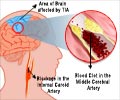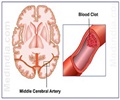People taking cholesterol-lowering drugs such as atorvastatin after a stroke may be at an increased risk of hemorrhagic stroke.
People taking cholesterol-lowering drugs such as atorvastatin after a stroke may be at an increased risk of hemorrhagic stroke, or bleeding in the brain, a risk not found in patients taking statins who have never had a stroke. The research is published in the Dec. 12, 2007, online issue of Neurology, the medical journal of the American Academy of Neurology.
For the study, researchers conducted a secondary analysis of the results of the Stroke Prevention with Aggressive Reduction in Cholesterol Levels (SPARCL) clinical trial. The trial enrolled 4,731 people who were within one to six months of having had a stroke or transient ischemic attack, or mini-stroke, and with no history of heart disease. Half of the participants received atorvastatin and half received a placebo. The participants were then followed for an average of four and a half years.Overall, treatment was associated with a 16-percent reduction in total stroke, the study’s primary endpoint, as well as significant reductions in coronary heart events. However, secondary analysis found that the overall reduction in stroke included an increase in the risk of brain hemorrhage. Of those people randomized to atorvastatin, the study found 2.3 percent experienced a hemorrhagic stroke during the study compared to 1.4 percent of those taking placebo. The study also found there was a 21-percent reduction in ischemic stroke, a more common type of stroke involving a block in the blood supply to the brain, among people taking atorvastatin.
Other factors were also found to increase the risk of brain hemorrhage. For example, those who had experienced a hemorrhagic stroke prior to the study were more than five times as likely to suffer a second stroke of this kind. Men were also nearly twice as likely as women to suffer a hemorrhagic stroke. People with severe high blood pressure at their last doctor’s visit prior to the hemorrhagic stroke had over six times the risk of those with normal blood pressure.
“Although treatment of patients with a stroke or transient ischemic attack was clearly associated with an overall reduction in a second stroke, hemorrhagic stroke was more frequent in people treated with atorvastatin, in those with a prior hemorrhagic stroke, in men and in those with uncontrolled hypertension,” according to study author Larry B. Goldstein, MD, with Duke University Medical Center in Durham, North Carolina, and Fellow of the American Academy of Neurology. “This risk of hemorrhagic stroke also increased with age.”
“Treatment with atorvastatin did not disproportionately increase the frequency of brain hemorrhage associated with these other factors. The risk of hemorrhage in patients who have had a transient ischemic attack or stroke must be balanced against the benefits of cholesterol-lowering drugs in reducing the overall risk of a second stroke, as well as other cardiovascular events,” said Goldstein.
Source-Eurekalert
KAR/P











